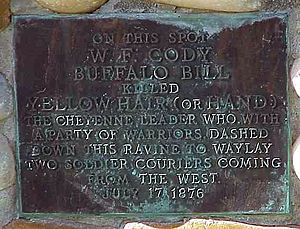Battle of Warbonnet Creek facts for kids
Quick facts for kids Battle of Warbonnet Creek |
|||||||
|---|---|---|---|---|---|---|---|
| Part of the Great Sioux War of 1876 | |||||||
|
|||||||
| Belligerents | |||||||
| Cheyenne | |||||||
| Commanders and leaders | |||||||
| Little Wolf | |||||||
| Strength | |||||||
| ~200-300 | ~350 | ||||||
| Casualties and losses | |||||||
| 1 killed unknown wounded |
None | ||||||
The Battle of Warbonnet Creek was a small fight that happened on July 17, 1876. It is famous for a special duel between "Buffalo Bill" Cody and a young Cheyenne warrior named Heova'ehe, or Yellow Hair. This battle took place in northwestern Nebraska, near what is now Sioux County.
Contents
Why the Battle Happened
After a Big Battle
After the Battle of the Little Bighorn, where General George A. Custer's soldiers were defeated, many Native American groups felt stronger. They were encouraged by the success of leaders like Sitting Bull and Crazy Horse.
Cheyenne Leave Their Homes
About 200 to 300 Cheyenne warriors, along with their families, decided to leave their homes. They were led by Morning Star, also known as Dull Knife. They left the reservations near Spotted Tail and Red Cloud in Nebraska.
The Army Responds
The United States Army sent the 5th Cavalry Regiment to stop any more groups from leaving. This cavalry unit was first led by Lt. Col. Eugene Asa Carr. Later, on July 1, Col. Wesley Merritt took command. When news of the Little Bighorn battle reached General George Crook, Merritt's soldiers were ordered to join Crook's forces in Wyoming.
The Fight at Warbonnet Creek
Finding the Cheyenne
Colonel Merritt soon learned that the Cheyenne had left their reservations. With help from "Buffalo Bill" Cody, Merritt and his soldiers were able to find the Cheyenne warriors.
Setting a Trap
Merritt planned a clever trap. He hid most of his 350 soldiers inside covered wagons. He also placed skilled shooters nearby, out of sight. The Cheyenne saw what looked like an unguarded group of wagons near Warbonnet Creek.
The Duel and the Ambush
A small group of six Cheyenne warriors charged forward. They wanted to distract the soldiers from the main Cheyenne group. Some warriors were hurt by the hidden soldiers.
The most famous part of this fight was a "duel." It happened between Buffalo Bill and a Cheyenne chief named Yellow Hand. Buffalo Bill used his Winchester carbine to shoot and kill Yellow Hand.
Cheyenne Retreat
The main group of Cheyenne warriors tried to help their small war party. But when they saw how many U.S. soldiers were really there, they quickly ran away. Not a single U.S. soldier was killed or injured in this battle.
After the Battle
Joining Forces
After the fight, Colonel Merritt and his soldiers joined General Crook's expedition. Later, General Alfred H. Terry's forces also joined them. This brought the total number of U.S. soldiers to about 4,000.
Buffalo Bill's Show
Buffalo Bill Cody was known for being a great showman. In October, he went back to performing on stage. His show featured a dramatic re-enactment of his duel with Yellow Hair. He even showed off Yellow Hair's feather war bonnet, knife, and saddle from the battle.


